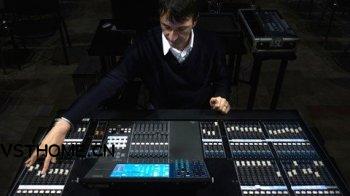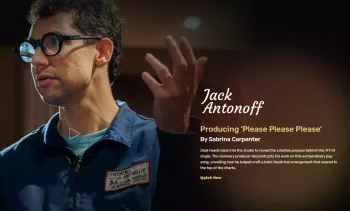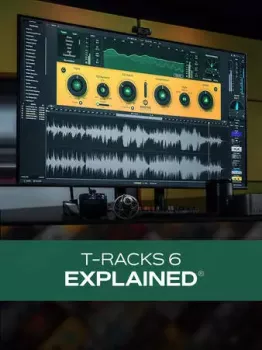Last updated 5/2021
MP4 | Video: h264, 1280x720 | Audio: AAC, 44.1 KHz
Language: English | Size: 17.21 GB | Duration: 13h 46m
英文简介:
Sound Engineering course for musicians, volunteers, professionals. For both beginners and people with some knowledge
What you'll learn
Be inspired like never before to pursuit great sound
Understand sound better in a musical, scientific and philosophical sense
Connect the language of music to the technical language of sound
Form the mindset of the greats behind sound production (for both live and recording)
Learn to select and use / position the right microphone for a given source
Understand and practise electronic matching
Learn to select and use / position the right microphone for a given source
Use the equalizer with in-depth understanding
Use the mixer correctly
Learn to choose and use the correct PA for a given room
Control feedback
Build a mix
Bring balance and beauty to a song
Requirements
Great passion for music and sound (that is the first and main requirement)
A DAW program is required, however a demo software is provided
Preferably a decent pair of headphones
Some basic understanding of math
Optional (a small mixer for the mixer session)
Description
The Sound Kitchen is a sound engineering course aimed at anyone who is passionate about sound and wants to learn the how-to's of great sound. The course uses lots of music and it is both inspirational and technical; but make no mistake, you will have more than your money’s worth of technical insight and input.The instruction is music based. Therefore there are always audio examples (there is also a lesson that will help you develop your hearing skills with audio clips you can download). We use a Digital Audio Workstation so that you can immediately put into practice the concepts expressed in some of the lessons, ending up making music (better) rather than just hearing someone talk about it. Furthermore, if you wanted to, you will be able to use the DAW (within the licensed time period) to exercise some sound engineering routines by yourself independently from the course.The course is very practical and the terminology is not overly technical (again do not assume that this is a shortfall, as often seasoned engineers have learned a great deal from the course approach and teachings). At the end of the course, you will be able to plan a sound production, choose well-suited equipment, set up a PA, and with practice, mix a production/song (live or in your home studio)."Ears before gear": is a sentence I coined to embody the idea that the most important piece of equipment to achieve great sound is the engineer. Ultimately great gear will sound poorly if the engineer cannot use it well. The opposite is also true that average gear in the right hands will sound great. This mindset is thematic across the entire course.The numbersA total of almost 14 hours of video tuition 69 video clips Manually entered Captions, so that everyone can understand every word9 sections9 quizzes (to help you review each section)89 audio clips (to download) used for hearing training 2 DAW program available (PC and MAC) each with a tailor-made sessionMulti-track songs performed by top South African musicians, recorded in a high-end studio in Cape Town, South AfricaPlenty of brain-stretching and ear developing DAW exercises I am confident that you will learn a great deal and will enjoy doing so. I look forward to seeing you among my new students. Ciao. Tim
Overview
Section 1: Introduction
Lecture 1 Course overview
Lecture 2 Before you start
Section 2: Definitions
Lecture 3 Definitions: Section overview
Lecture 4 Defining sound
Lecture 5 Defining sound engineering
Lecture 6 Defining a sound system; 3 qualities of a great engineer
Lecture 7 Laws of perceptions
Section 3: 3 Distinctive Characters of Sound
Lecture 8 3 Distinctive Characters of Sound: Section overview
Lecture 9 Pitch
Lecture 10 Intensity part A
Lecture 11 Intensity part B
Lecture 12 Intensity: clarification
Lecture 13 Timbre 1 part A
Lecture 14 Timbre 1 part B
Lecture 15 Timbre 2 part A
Lecture 16 Timbre 2 part B
Lecture 17 Hearing training preface
Lecture 18 Hearing Training
Section 4: Sound Control
Lecture 19 Sound Control: Section overview
Lecture 20 Sound Production Architecture
Lecture 21 Sound Production Architecture - observations
Lecture 22 Sound Manipulation part A
Lecture 23 Sound Manipulation part B
Lecture 24 Sound Isolation part A
Lecture 25 Sound Isolation part B
Section 5: Cables & D.I. Box
Lecture 26 Cables & D.I. Box: Section overview
Lecture 27 Cables 1
Lecture 28 Cables 2
Lecture 29 D.I. Boxes
Lecture 30 D.I. Box part B
Section 6: Microphones
Lecture 31 Microphones: Section overview
Lecture 32 Microphones 1
Lecture 33 Microphones 2
Lecture 34 Microphones 3
Lecture 35 Microphones 4
Section 7: Equalizer
Lecture 36 Equalizer: Section overview
Lecture 37 Equalizer section preface VERY IMPORTANT
Lecture 38 PC DAW overview
Lecture 39 MAC DAW overview
Lecture 40 Signal processing
Lecture 41 Introduction to the Equalizer
Lecture 42 Band types
Lecture 43 Band “shapes” 1, 2 & 3
Lecture 44 Band “shapes” 4 & 5
Lecture 45 Tone processing steps & practical tips part A
Lecture 46 Tone processing steps & practical tips part B
Lecture 47 Tone processing steps & practical tips part C
Lecture 48 Tone processing steps & practical tips part D
Section 8: Mixer
Lecture 49 Mixer: Section overview
Lecture 50 Basic mixer architecture logic
Lecture 51 Routing 1
Lecture 52 Metering
Lecture 53 Gain structure
Lecture 54 Level setting
Lecture 55 Routing 2 part A: output types
Lecture 56 Routing 2 part B: most common routing types
Lecture 57 Routing 3: channel to masters patching
Section 9: Loudspeakers
Lecture 58 Loudspeakers: Section overview
Lecture 59 Defining a loudspeaker
Lecture 60 The Crossover System
Lecture 61 6 important aspects of a speaker part A
Lecture 62 6 important aspects of a speaker part B
Lecture 63 6 important aspects of a speaker part C
Lecture 64 Setting up in a room: speaker choice
Lecture 65 Setting up in a room: speaker placement
Lecture 66 Feedback part A
Lecture 67 Feedback part B
Section 10: Mix
Lecture 68 Mix: Section overview
Lecture 69 Basic mixing principles
Lecture 70 Musical components part A
Lecture 71 Musical components part B
Lecture 72 Fundamental and filler sounds
Lecture 73 The masking principle
Lecture 74 What can I drop?
The course is suitable for people with different knowledge and skill levels, ranging from people with no knowledge to people that work in this field.,Musicians who want to understand sound engineering better,Sound engineers,Sound volunteers in churches/school,People with some background knowledge that want to expand their understanding of sound engineering






![French Connections: From Discotheque to Daft Punk – The Birth of French Touch by Martin James EPUB [EN]](https://audioz.download/uploads/posts/2024-09/thumbs/1727455731_407930774.webp)
评论0